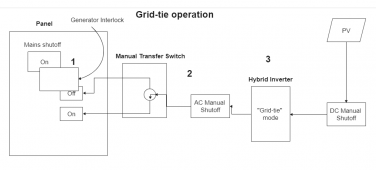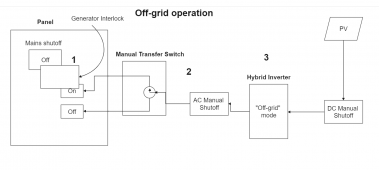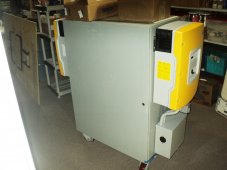Hi, I am currently just brainstorming design for a way to use solar in a grid-tie and off-grid situation. I don't need immediate transfer of power, but the ability to go out and flip a few switches would be nice to enable my solar to continue running. I have been doing a lot of reading of forums and manuals and I am getting answers from "it can't be done" to "yes absolutely".
I know some hybrid inverters allow you to input utility AC power to the inverter, then power your load with that power if your solar + battery can't handle it. It appears like they may handle it different ways too, like with MPP's transfer switch - when power is insufficient it just transfers the whole load to utility, or with Outback Radian's Grid Zero mode - when power is insufficient, it blends utility power with the solar power to power your load.
I would LOVE to get a hybrid inverter and just power my entire home panel off hybrid inverters with utility input, but I need something that is more "reliable" than depending on inverters not failing. I may be out of the country for several months and have my property rented for a vacation rental property. I also have two air conditioners and can have massive current spikes, and if I pass through an inverter I may need to wayyyy overbuild my inverters just to do this? From what I understand, I can do an automatic transfer switch that will just connect directly to utility if my inverters fail but.... meh?
I also don't want to have an inverter subpanel that is protected, while the rest of the home is offline. I feel like I won't use the solar array to it's full potential then.
I am looking at hybrid inverters that can do both grid-tie and off-grid, like the Outback Radian. I drew up a very basic wiring diagram of what I imagine the system could look like in both grid-tie mode and off-grid mode.
Is this possible like the wiring diagrams?
Is there a better way to do this?
Would it be reliable enough going through the inverters?
EDIT: During power outages I don't need to run both my AC's. What the array generates is just fine during outages, but when utility is up I would like to be able to draw more than my inverter is rated for.


I know some hybrid inverters allow you to input utility AC power to the inverter, then power your load with that power if your solar + battery can't handle it. It appears like they may handle it different ways too, like with MPP's transfer switch - when power is insufficient it just transfers the whole load to utility, or with Outback Radian's Grid Zero mode - when power is insufficient, it blends utility power with the solar power to power your load.
I would LOVE to get a hybrid inverter and just power my entire home panel off hybrid inverters with utility input, but I need something that is more "reliable" than depending on inverters not failing. I may be out of the country for several months and have my property rented for a vacation rental property. I also have two air conditioners and can have massive current spikes, and if I pass through an inverter I may need to wayyyy overbuild my inverters just to do this? From what I understand, I can do an automatic transfer switch that will just connect directly to utility if my inverters fail but.... meh?
I also don't want to have an inverter subpanel that is protected, while the rest of the home is offline. I feel like I won't use the solar array to it's full potential then.
I am looking at hybrid inverters that can do both grid-tie and off-grid, like the Outback Radian. I drew up a very basic wiring diagram of what I imagine the system could look like in both grid-tie mode and off-grid mode.
Is this possible like the wiring diagrams?
Is there a better way to do this?
Would it be reliable enough going through the inverters?
EDIT: During power outages I don't need to run both my AC's. What the array generates is just fine during outages, but when utility is up I would like to be able to draw more than my inverter is rated for.


Last edited:



